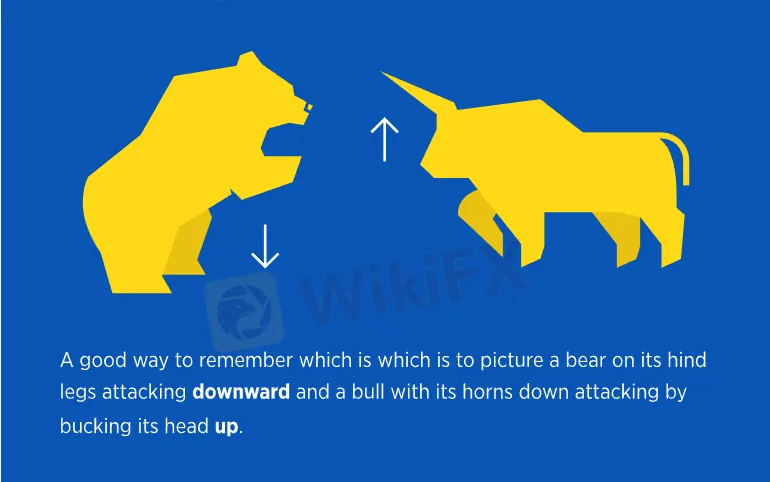简体中文
繁體中文
English
Pусский
日本語
ภาษาไทย
Tiếng Việt
Bahasa Indonesia
Español
हिन्दी
Filippiiniläinen
Français
Deutsch
Português
Türkçe
한국어
العربية
What Are Bearish and Bullish Markets?
Abstract:Simply put, a bear market is one in which prices are heading down and a bull market is used to describe conditions in which prices are rising.

When the bulls reign in the market, people are looking to invest money; confidence is high and the acceptance of risk generally goes up.
This leads to rises in various markets – particularly in stock markets, but also in FX currencies such as the Australian dollar (AUD), Canadian dollar (CAD), New Zealand dollar (NZD), and emerging market currencies. Conversely, bull markets typically lead to a decline in safe-haven currencies such as the Japanese yen, the Swiss franc (CHF) and, in some cases, the U.S. dollar.
The U.S. dollar (USD) and Japanese yen (JPY) are safe-haven currencies and tend to strengthen in a bear market as riskier instruments are sold off and safe-haven currencies are in demand.
Why Does It Matter to You?
One of the key benefits of forex trading is the opportunity it offers traders in both bull and bear markets. This is because forex trading is always done in pairs, when one currency is weakening the other is strengthening thereby allowing you to take advantage of rising and falling markets.
Bull and bear markets are important to pay attention to as they can determine currency market trends. By being aware of market trends, can help you to make the best decisions of how to manage risk and gain a better understanding of when it is best to enter and exit your trades.
In a bull market, traders are looking to enter the market when prices are rising so that they can sell once they believe the market has reached its peak.What Happens in a Bear Market?
Bearish markets follow a downward trend as investors sell riskier assets such as stocks and less-liquid currencies such as those from emerging markets.
In a bear market, traders are looking to enter the market when prices are falling so that they can buy once they believe that market has reached its peak.
The U.S. dollar (USD) and Japanese yen (JPY) are safe-haven currencies and tend to strengthen in a bear market as riskier instruments are sold off and safe-haven currencies are in demand.
Why Does It Matter to You?
One of the key benefits of forex trading is the opportunity it offers traders in both bull and bear markets. This is because forex trading is always done in pairs, when one currency is weakening the other is strengthening thereby allowing you to take advantage of rising and falling markets.
Bull and bear markets are important to pay attention to as they can determine currency market trends. By being aware of market trends, can help you to make the best decisions of how to manage risk and gain a better understanding of when it is best to enter and exit your trades.

Disclaimer:
The views in this article only represent the author's personal views, and do not constitute investment advice on this platform. This platform does not guarantee the accuracy, completeness and timeliness of the information in the article, and will not be liable for any loss caused by the use of or reliance on the information in the article.
Read more

The Daily Habits of a Profitable Trader
Every professional trader follows a structured approach to ensure they are well-prepared, disciplined, and able to seize opportunities with confidence. Whether you are a seasoned investor or an aspiring trader, adhering to a robust daily checklist can significantly enhance your performance. Use this checklist to check if you are a qualified trader

Authorities Alert: MAS Impersonation Scam Hits Singapore
MAS scam alert: Scammers impersonate officials, causing $614K losses in Singapore since March 2025. Learn how to spot and avoid this impersonation scam.

Billboard Warns of Crypto Scams Using Its Name – Stay Alert!
Billboard warns against fake crypto scams using its brand. Learn how to spot fraud and protect yourself from fake promotions.

The Impact of Interest Rate Decisions on the Forex Market
Interest rate changes determine currency attractiveness, influencing capital flows and exchange rate trends. Understanding this mechanism helps investors navigate the forex market effectively.
WikiFX Broker
Latest News
The Withdrawal Trap: How Scam Brokers Lure Victims into Paying More
FCA to Investors: Think Twice Before Trusting These Brokers
Trump\s tariffs: How could they affect the UK and your money
Trump gambles it all on global tariffs he\s wanted for decades
TradingView Brings Live Market Charts to Telegram Users with New Mini App
Trump tariffs: How will India navigate a world on the brink of a trade war?
Interactive Brokers Launches Forecast Contracts in Canada for Market Predictions
Authorities Alert: MAS Impersonation Scam Hits Singapore
IG Group Acquires Freetrade for £160M to Expand UK Investment Market
U.S. March ISM Manufacturing PMI Released
Currency Calculator







